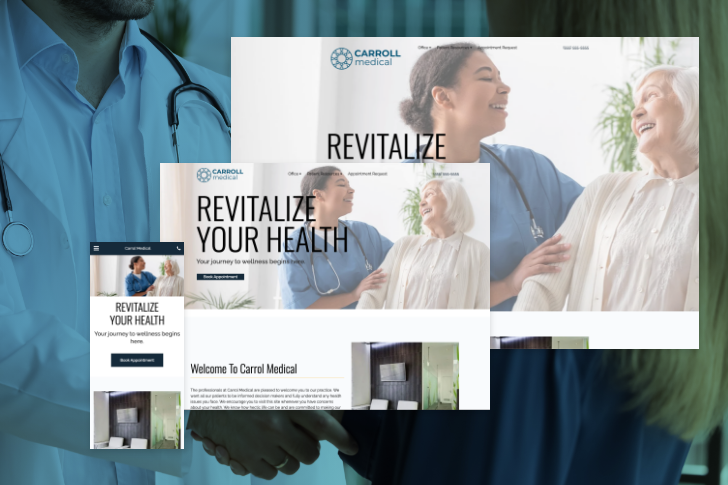Effective advertising is vital for any medical practice seeking to attract and retain patients. With the healthcare industry becoming increasingly competitive, standing out among other clinics and healthcare brands is more challenging than ever. Effective advertising can lead to better health outcomes for patients by enhancing patient experiences and improving overall satisfaction. To capture potential patients’ attention, adopting marketing strategies tailored to your practice’s unique strengths is crucial. However, navigating the vast array of advertising options can feel daunting.
This article will guide you through various advertising ideas to help medical practices reach a broader audience, foster patient trust, and ultimately grow your practice. From leveraging digital marketing tools like social media and search engine optimization to implementing patient referral programs, numerous ways exist to enhance your visibility and credibility in the market. By focusing on the right strategies, you can ensure that your practice attracts new patients and builds long-term relationships with them, leading to sustained growth and success.
1. Understanding Healthcare Advertising
Healthcare advertising is a cornerstone of the healthcare industry, playing a pivotal role in promoting healthcare products, services, facilities, and initiatives to targeted audiences. It encompasses a variety of strategies and channels designed to raise awareness, educate, and persuade individuals about healthcare-related topics. Effective healthcare advertising can break down barriers that prevent people from seeking care, making them feel more comfortable and confident in choosing their healthcare team.
Healthcare advertising can take many forms, including digital marketing, social media campaigns, print media, and television advertising. Healthcare marketing agencies specialize in these various forms, addressing the distinct needs and regulations of the healthcare industry. Each medium offers unique advantages in reaching different segments of the population. For instance, digital marketing and social media are excellent for targeting younger demographics who are more likely to seek information online, while print media and television can effectively reach older audiences.
The primary goal of healthcare advertising is to convey messages clearly and concisely, ensuring that the target audience understands the benefits and importance of the healthcare services or products being promoted. Healthcare organizations can use advertising not only to promote their offerings but also to educate the public on various health-related topics, thereby fostering a more informed and health-conscious community.
1.1 What is Healthcare Advertising?
Healthcare advertising refers to the marketing and promotion of healthcare products, services, facilities, or initiatives to target audiences. It encompasses various strategies and channels to raise awareness, educate, and persuade individuals about healthcare-related topics. Effective healthcare advertising can break down barriers that prevent people from seeking care, making them feel more comfortable and confident in choosing their healthcare team.
Healthcare advertising can take many forms, including digital marketing, social media campaigns, print media, and television advertising. Each medium offers unique advantages in reaching different segments of the population. For instance, digital marketing and social media are excellent for targeting younger demographics who are more likely to seek information online, while print media and television can effectively reach older audiences.
The primary goal of healthcare advertising is to convey messages clearly and concisely, ensuring that the target audience understands the benefits and importance of the healthcare services or products being promoted. Healthcare organizations can use advertising not only to promote their offerings but also to educate the public on various health-related topics, thereby fostering a more informed and health-conscious community.
1.2 Benefits of Healthcare Advertising for Healthcare Organizations
Healthcare advertising offers numerous benefits for healthcare organizations, including increased brand awareness, improved patient engagement, and enhanced reputation. By promoting their services and products, healthcare organizations can attract new patients, retain existing ones, and ultimately drive business growth. Effective healthcare advertising can also help organizations establish themselves as thought leaders in the industry, build trust with their target audience, and improve health outcomes.
Increased brand awareness is one of the most significant benefits of healthcare advertising. By consistently promoting their services and products, healthcare organizations can ensure that they remain top-of-mind for potential patients. This increased visibility can lead to a higher volume of patient inquiries and appointments.
Improved patient engagement is another critical benefit. Through targeted advertising campaigns, healthcare organizations can provide valuable information and resources to their patients, encouraging them to take an active role in their health and wellness. This can lead to better health outcomes and higher patient satisfaction.
Enhanced reputation is also a crucial advantage. By effectively communicating their expertise and the quality of their services, healthcare organizations can build trust with their target audience. This trust can translate into long-term patient relationships and positive word-of-mouth referrals, further driving business growth.
2. Leverage Local SEO in Healthcare Marketing to Increase Visibility
Local search engine optimization (SEO) is a powerful tool for healthcare providers looking to connect with potential patients in their area. By optimizing your website and online presence for local search, you can increase your practice’s visibility in search engine results when people search for healthcare services near them.
First, ensure your Google Business Profile is fully optimized with accurate information, including your practice’s name, address, phone number, and business hours. Regularly update your profile with new photos, posts, and patient reviews to keep it engaging and relevant. Incorporating local keywords in your website’s content, meta descriptions, and title tags is also crucial. For example, if you’re a dental practice in Chicago, using phrases like “top dentist in Chicago” or “Chicago dental services” can help you rank higher in local searches.
Health systems can benefit from adopting sophisticated marketing strategies to enhance consumer engagement and support their growth objectives. Partnering with top healthcare marketing agencies can provide exceptional marketing solutions tailored for the healthcare industry, leveraging innovative strategies and deep industry knowledge to differentiate your practice from others.
Don’t forget to optimize your website for mobile users, as many potential patients will search for healthcare services on their smartphones. A mobile-friendly site that loads quickly and is easy to navigate can significantly improve your chances of attracting new patients.
3. Create Engaging Social Media Campaigns
Social media is an invaluable platform for healthcare providers to engage with current and potential patients. With billions of users across platforms like Facebook, Instagram, and Twitter, social media offers a unique opportunity to reach a broad audience and humanize your practice.
Start by creating content that resonates with your target audience. This can include sharing patient success stories (with their permission), looking behind the scenes at your practice, providing health tips, and posting informational posts about your services. Use visuals like photos and videos to make your content more engaging and encourage interaction through comments, likes, and shares.
Regular posting is essential, but so is responding to comments and messages. Active engagement shows that your practice is attentive and caring, which can help build trust with potential patients. Use paid social media ads to target specific demographics, such as age, location, and interests, to reach those most likely to need your services.
4. Implement Google Ads for Targeted Reach
Google Ads can effectively attract new patients by placing your practice at the top of search engine results for relevant keywords. Unlike organic SEO, which can take time to show results, Google Ads offers immediate visibility, making it a valuable tool for healthcare providers looking to increase their online presence quickly.
Identify the keywords potential patients might use when searching for your services. For instance, a family doctor might target keywords like “family doctor near me” or “pediatric care.” Once you’ve identified your keywords, create ad campaigns highlighting your practice’s unique selling points, such as same-day appointments or specialized care.
Google Ads allows you to set a budget and only pay when someone clicks on your ad, making it a cost-effective option for healthcare marketing. Additionally, you can track the performance of your ads through Google Analytics, allowing you to adjust your strategy based on what’s working.
5. Develop a Patient Referral Program for Healthcare Professionals
Word-of-mouth remains one of the most effective ways to attract new patients. Developing a patient referral program incentivizes current patients to recommend your services to friends and family. Not only does this bring in new patients, but it also reinforces loyalty among your existing ones.
Consider rewarding patients who refer others to your practice to create a successful referral program. This could be through discounts on services, gift cards, or even a charitable donation in their name. Promote your referral program in person at your practice and online through your website and social media channels.
Remember to keep the referral process straightforward. Provide patients with easy ways to refer others, such as a dedicated referral link or a printed card they can share.
6. Create Educational Content on Medical Services to Build Authority
Educational content is a crucial component of digital healthcare marketing that can help position your practice as an authority in your field. By sharing valuable information about your services, you can attract patients seeking expert advice and trustworthy care.
Healthcare professionals play a vital role in creating and sharing educational content to build trust and authority. This includes information on medical devices, which are essential in promoting preventive care and educating patients.
Start by identifying common questions or concerns your patients have and create content that addresses these topics. This can be blog posts, videos, infographics, or even webinars. For example, if you’re a physical therapist, you could create content on managing chronic pain, recovering from injuries, or the benefits of physical therapy.
Educational content not only helps potential patients understand the services you offer but also builds trust in your expertise. Share this content across your website, social media channels, and email newsletters to reach as broad an audience as possible.
To further enhance your understanding of effective healthcare advertising strategies and stay updated with the latest trends, consider exploring our comprehensive collection of healthcare blogs for doctors. This resource is designed to provide in-depth insights and practical tips tailored specifically for medical professionals looking to refine their marketing efforts.
7. Utilize Email Marketing for Patient Retention
Email marketing is a powerful tool for keeping your practice up-to-date with current and potential patients. Regularly sending out informative and engaging emails can nurture relationships with your patients and encourage them to return for future services.
Start by building an email list of your patients and website visitors. To encourage sign-ups, offer valuable content, such as health tips, practice updates, or exclusive promotions. Once you have a list, segment it based on patient needs or interests to send more personalized messages.
Consistency is vital in email marketing. Whether you’re sending monthly newsletters, appointment reminders, or special offers, regular communication helps maintain a connection with your patients. Be sure to include clear calls-to-action in your emails, such as scheduling an appointment or visiting your website, to drive engagement.
8. Host Community Events and Workshops in the Health and Wellness Industry
Engaging with your community through events and workshops is an excellent way to increase your practice’s visibility. While these events may occur in person, digital marketing can significantly benefit their promotion and follow-up. For instance, you can create event pages on social media platforms like Facebook or Instagram, where potential patients can RSVP and share the event with their networks. Additionally, livestreaming your workshops on platforms like YouTube or Facebook Live can attract a wider audience, including those who cannot attend in person.
Hosting events also allows you to showcase your expertise in specific areas of healthcare, thereby building trust with potential patients. After the event, consider sending follow-up emails or newsletters to attendees, offering additional resources, or inviting them to book an appointment.
9. Offer New Patient Specials and Discounts
Offering special promotions or discounts for new patients is a time-tested way to attract interest, especially when coupled with digital marketing efforts. Creating dedicated landing pages on your website for these offers can help you capture leads more effectively. Additionally, using targeted online ads on platforms like Google Ads or Facebook can help you reach individuals actively searching for healthcare services in your area.
Promotions can also be highlighted in email campaigns aimed at potential patients who have shown interest in your services but haven’t yet booked an appointment. By offering a financial incentive, you can nudge these leads toward making their first visit to your practice.
10. Invest in High-Quality Website Design
Your website often gives potential patients the first impression of your practice. A high-quality, user-friendly website can significantly impact how patients perceive your practice. Ensure your website is mobile-responsive, as many users access healthcare information via smartphones. The design should be clean, professional, and easy to navigate, with clear calls to action encouraging visitors to schedule appointments or contact your office.
Beyond aesthetics, ensure your website is optimized for search engines (SEO). This includes using relevant keywords, having fast load times, and providing valuable content that answers common patient questions. An SEO-optimized website will rank higher in search engine results, making it easier for potential patients to find you. To view Officite’s entire gallery of modern, responsive medical website designs, please fill out the form below.
Preview Your New Website Now!
11. Video Marketing for Healthcare
Video marketing has emerged as a powerful tool for healthcare organizations to promote their services, products, and initiatives. It offers a dynamic way to educate patients, raise awareness, and build trust with the target audience. Healthcare video marketing can take many forms, including explainer videos, patient testimonials, and educational content.
Explainer videos can simplify complex medical procedures or treatments, making them more understandable for patients. Patient testimonials provide real-life stories that can resonate with potential patients, showcasing the positive experiences of others. Educational videos can cover a wide range of topics, from preventive health tips to detailed explanations of medical conditions and treatments.
By incorporating video marketing into their marketing strategy, healthcare organizations can reach a wider audience and increase engagement. Videos are highly shareable on social media platforms, which can significantly boost brand awareness. Additionally, video content can enhance a healthcare provider’s online presence, making it easier for potential patients to find and trust their services.
Healthcare organizations that leverage video marketing effectively can build stronger connections with their audience, ultimately driving more patients to their practice. The visual and emotional appeal of videos makes them an invaluable asset in the health and wellness industry.
12. Collaborate with Local Businesses
Partnering with local businesses can be a powerful strategy for expanding your medical practice’s reach while benefiting the community. By collaborating with companies like gyms, wellness centers, or health food stores, you tap into a new audience already invested in health and wellness. This audience will likely be interested in your services, making these partnerships an effective way to attract potential patients who align with your practice’s focus.
One practical approach is to offer joint promotions, such as a discount on a first consultation at your practice for customers of the partner business. This not only incentivizes new patients to try your services but also adds value to the offerings of your partner business, creating a win-win situation. Additionally, you could co-host health-related events, such as wellness workshops or fitness challenges. These events allow direct interaction with potential patients, allowing you to showcase your expertise and build trust within the community.
Promoting them through digital channels is essential to maximize the impact of these collaborations. Sharing joint promotions and events on social media, email newsletters, and your website can help you reach a broader audience. Featuring your partners in blog posts or social media content strengthens the partnership and enhances your practice’s visibility and credibility. These efforts can build goodwill, making your practice more recognizable and trusted in the community.
13.Utilize Online Reviews to Build Trust as a Healthcare Provider
Online reviews are critical in building trust with potential patients in the digital age. Encourage satisfied patients to leave reviews on platforms like Google, Yelp, and Healthgrades. Positive reviews can significantly impact your practice’s reputation and help attract new patients researching their options online.
Responding to reviews, whether positive or negative, is equally important. A thoughtful response to a negative review can demonstrate your commitment to patient care and potentially turn a dissatisfied patient into a loyal one. Additionally, showcasing positive reviews on your website and social media platforms can enhance your credibility and appeal to new patients.
14. Use Direct Mail to Reach Local Residents
While digital marketing is essential, traditional methods like direct mail can still be highly effective, especially when integrated with digital campaigns. Sending targeted postcards, brochures, or newsletters to local residents can help you reach potential patients who may not be actively searching for healthcare services online but still need care.
Including a unique URL or QR code on your direct mail pieces can drive recipients to a specific landing page on your website, where they can learn more about your services or book an appointment. Combining direct mail with online follow-ups, such as retargeting ads, can reinforce your message and keep your practice top-of-mind.
15. Run Retargeting Ads to Reengage Visitors
Retargeting ads are a powerful tool for reengaging visitors who have shown interest in your practice but haven’t yet taken action. These ads are displayed to individuals who have visited your website or interacted with your social media profiles, reminding them of your services and encouraging them to return.
For example, suppose a potential patient visits your website to read about a specific treatment but doesn’t schedule an appointment. In that case, a retargeting ad can remind them of your practice when they browse other websites or social media platforms. This strategy makes your practice visible and helps convert interested leads into patients.
16. Transparency in Healthcare Advertising
Transparency is a cornerstone of effective healthcare advertising, as it helps build trust with the target audience. Healthcare organizations should prioritize transparency by providing clear and concise information about their services, products, and initiatives. This can include clear labeling, honest messaging, and transparent pricing.
Transparent healthcare advertising can take many forms. For example, clear labeling ensures that patients understand what they are getting, whether it’s a medical device, a pharmaceutical product, or a healthcare service. Honest messaging involves communicating the benefits and potential risks of treatments or services without exaggeration. Transparent pricing helps patients make informed decisions by understanding the costs involved upfront.
By being transparent in their advertising efforts, healthcare organizations can demonstrate their commitment to providing high-quality care and services. This approach not only builds trust but also increases the effectiveness of their marketing efforts. Patients are more likely to choose a healthcare provider they perceive as honest and straightforward.
Incorporating transparency into healthcare advertising is essential for building long-term relationships with patients. It fosters trust, increases engagement, and ultimately drives more patients to healthcare organizations, ensuring sustained growth and success in the competitive healthcare industry.
16.1 Compliance with Healthcare Regulations
Compliance with healthcare regulations is a critical aspect of healthcare marketing. Healthcare marketing agencies must ensure that their strategies adhere to regulations such as HIPAA and FDA guidelines. This includes protecting patient data, avoiding false or misleading claims, and adhering to industry standards for advertising and promotion.
Protecting patient data is paramount. Healthcare marketing agencies must implement robust data protection measures to ensure that patient information is secure. This not only helps in maintaining compliance but also builds trust with patients, who are more likely to engage with a healthcare provider that prioritizes their privacy.
Avoiding false or misleading claims is another essential aspect of compliance. Healthcare marketing agencies must ensure that all promotional materials accurately represent the services and products being offered. This includes providing clear information about the benefits and potential risks of treatments or services.
Adhering to industry standards for advertising and promotion is also crucial. This includes following guidelines set by regulatory bodies such as the FDA, which govern how healthcare products and services can be marketed. By prioritizing compliance, healthcare marketing agencies can help healthcare organizations avoid potential fines and penalties, maintain their reputation, and build trust with their target audience.
17. Align Marketing with Organizational Objectives
Aligning marketing with organizational objectives is crucial for healthcare organizations to achieve their goals and drive business growth. This involves integrating marketing strategies with overall business objectives, such as increasing patient volume, improving patient satisfaction, and enhancing reputation.
To effectively align marketing with organizational objectives, healthcare organizations should start by clearly defining their business goals. This could include specific targets for patient acquisition, retention, or satisfaction. Once these goals are established, marketing strategies can be developed to support them.
For example, if a healthcare organization aims to increase patient volume, marketing efforts could focus on targeted advertising campaigns that highlight the unique benefits of their services. If the goal is to improve patient satisfaction, marketing strategies could include educational content that helps patients better understand their treatment options and feel more confident in their care.
By aligning marketing with organizational objectives, healthcare organizations can ensure that their marketing efforts are targeted, effective, and measurable. This alignment helps in maximizing the return on investment for marketing activities and ensures that all efforts contribute to the overall success of the organization.
18. Create a Seamless Digital Patient Experience
Creating a seamless digital patient experience is essential for healthcare organizations to attract and retain patients in today’s digital age. This involves designing a user-friendly website, leveraging social media, and utilizing digital marketing channels to engage patients and provide them with relevant information.
A user-friendly website is the cornerstone of a seamless digital patient experience. The website should be easy to navigate, mobile-responsive, and provide clear information about the services offered. Features such as online appointment scheduling, patient portals, and live chat support can enhance the user experience and make it easier for patients to interact with the practice.
Leveraging social media is another critical component. Healthcare organizations can use platforms like Facebook, Instagram, and Twitter to share valuable content, engage with patients, and build a community. Social media can also be used to promote events, share patient testimonials, and provide health tips, further enhancing patient engagement.
Utilizing digital marketing channels, such as email marketing and online advertising, can also help in creating a seamless digital patient experience. These channels can be used to send personalized messages, appointment reminders, and promotional offers, keeping patients informed and engaged.
By creating a seamless digital patient experience, healthcare organizations can improve patient satisfaction, increase patient engagement, and drive business growth. This approach ensures that patients have a positive and consistent experience across all digital touchpoints, making them more likely to choose and remain loyal to the practice.
Key Takeaways
Attracting and retaining new patients in the digital age requires a multifaceted approach that combines online and offline strategies. By hosting community events, offering new patient specials, investing in a high-quality website, collaborating with local businesses, leveraging online reviews, using direct mail, and running retargeting ads, healthcare providers can effectively reach a broader audience and build lasting relationships with their patients.
Having a proven track record in healthcare advertising is crucial to building trust and credibility with potential patients.
These digital healthcare marketing strategies enhance your practice’s visibility and foster trust and credibility, essential elements for long-term success in the competitive healthcare industry. By consistently implementing these tactics, you can ensure your practice remains a preferred choice for patients seeking quality care.

Maryrose Dooley expertly guides small practices through the digital landscape, offering marketing strategies to attract more patients. Her unique blend of business acumen and design expertise creates visually appealing solutions that set businesses apart. With a passion for leveraging technology, Maryrose helps businesses of all sizes achieve their goals and stand out from the competition.
















